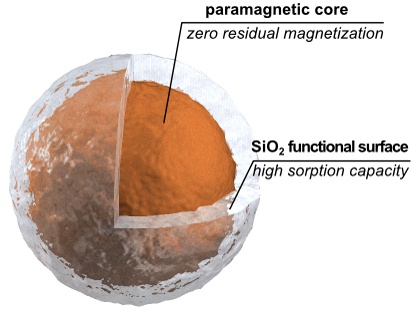Magnetic nanoparticles are interesting little tools. They are not magnetic themselves, butmagnets can control them. They are deemed safe for use in biological and medical applications, but they have a seemingly mysterious ability to “bind” to “anything” a scientist or doctor wants them to. They can isolate cells and DNA, destroy tumors, and deliver drugs to specific cells or tissues. How can all of this be so? As with most things, the answers to these mysterious properties can be found by examining the way magnetic nanoparticles are constructed.
Paramagnetic Core
The material at the core of the nanoparticle dictates itsmagnetic behavior. This core is most commonly made of iron oxide (Fe3O4). Iron oxide at the nanometer scale is paramagnetic, which means that it has no magnetism by itself. However, it can become magnetic when placed in close proximity to a permanent magnet. The permanent magnet influences the magnetic dipoles of the iron oxide particles, which causes the particlesto rotate (due to torque from a constant magnetic field) or change location (in a magnetic field gradient). This means that an iron oxide particle will not change its location when placed into a constant magnetic field. The only time an iron oxide particle will change location is when influenced by a magnetic field with varying magnitude or direction in space, which iscalled a magnetic field gradient. In this situation the magnetic force is greater on one side of the field than the other, with a smooth transition between sides. A permanent magnet creates a magnetic field gradient whereby themagnetic force is greatest nearby the magnet and weakest far away from the magnet. If a paramagnetic iron oxide particle is placed into the middle of this magnetic field gradient it will be forced to move toward the side of greater magnetic force.
Protective Coating
The iron oxide core is the magnetically functional part of a magnetic nanoparticle, but this core alone is a useless biotechnology tool. To improve the particle for biological applications it needs to be coated. The reason for this is two-fold. The first purpose of the coating is to protect the iron oxide from breaking down and being toxic to the living system. The second purpose is to make the particle inert so that it doesn’t react to everything it comes into contact with, including other particles. The particles are supposed to aggregate when a magnetic field gradient is applied, but this is not desirable in a zero or constant magnetic field. Some of the coatings used to achieve these goals include citrate, polyacrylate, and silica. These and other coatings typically contain carboxyl, hydroxyl, phosphate, phosphonate sulfate, and sufonate groups that grab onto the iron oxide.
Functional Moieties
The functional moiety is the part of the magnetic nanoparticle that makes it such a diverse and important tool in biotechnology. Until this point in the article our understanding of the magnetic nanoparticle is limited to a paramagnetic core coated with a biologically inert material. This is not very useful. Now we need to apply something that allows these particles to bind specifically to a cell or tissue of interest. This is the part that allows magnetic nanoparticles to have diverse applications including magnetic activated cell sorting, magnetic
DNA purification, directing tissue growth and graft localization, bacteria and virus detection, drug delivery systems, cancer treatment, and enhanced magnetic resonance imaging (MRI).
One example of a functional moiety is an antibody. The antibody is attached to the coated nanoparticle. This type of magnetic nanoparticle is used when a scientist needs to isolate a specific cell type from a group of many different cells. Here, the scientist would choose a magnetic particle with an antibody that binds to an identifying antigen on the cell of interest. There are many magnetic particles commercially available for this purpose. The scientist simply has to find the antigen that identifies the cell, purchase magnetic nanoparticles coated with the antibody that binds to it, and perform magnetic activated separation to collect the cells. Of course, if a nanoparticle with the necessary antibody is not commercially available then the scientist might have to find a graduate student to synthesize it in the lab and publish a paper about it.
Antibodies aren’t the only functional moiety available for magnetic nanoparticles. There are also enzymes and nucleotides. Also, the particles can be further coated with substances that make the particles attracted or repelled by water, which affects the way the particle interacts with cell membranes. There are many successful companies developing and selling magnetic nanoparticles with a large variety of specific functions. Additionally, researchersare always finding new ways to attach various functional moieties to magnetic nanoparticles. Sometimes it seems that the possibilities are only limited by the scope of one’s imagination and creativity. Of course, a good understanding of chemistry and biology goes a long way too.
Related news:





